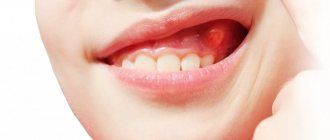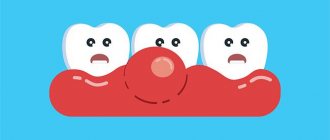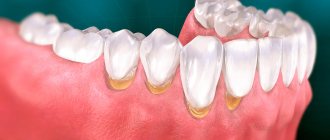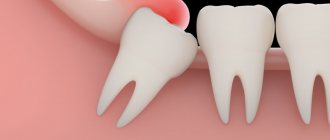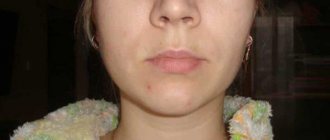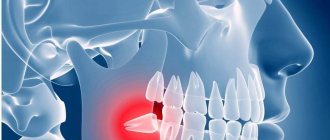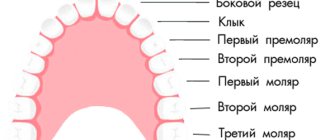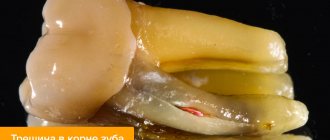Why do ulcers appear on the gums, and is it always dangerous?
There are many possible reasons. To understand how dangerous the appearance of certain lesions on the gums is, you need to look at additional accompanying symptoms:
- in case it is trivial mechanical damage. The gums can be damaged by hard food, a toothbrush, or a foreign object. These lesions may resolve in 3-5 days. If a person does not brush his teeth, then infection is added to these damages, and healing may take several weeks.
- Sometimes ulcers can appear as a result of wearing orthodontic structures, braces or removable dentures.
Gum abscess - symptoms and treatment
Gum abscess is caused by pathogens of the oral microflora, which is mainly represented by the following bacteria:
- Bacteroides forsythus (in 55.6% of cases);
- Porphyromonas gingivalis (50.0%);
- Fusobacterium nucleatum (44.4%),
- A. actinomycetemcomitans (38.9%);
- Prevotella intermedia (38.9%) and others.
In addition, in most cases, periodontal pathogens enter into symbiosis with fungi of the genus Candida (44.4%), bacteria Enterobacter (38.9%), Streptococcus intermedius (13.2%), Peptostreptococcus micros (13.2%) and Staphylococcus aureus (28.5%) [4].
The pathogenesis of the disease varies depending on the location of the inflammation.
1. An abscess that arises as a result of pathological processes in periodontal tissues. Inadequate treatment of tooth root canals leads to acute inflammation or exacerbation of its chronic form in the periodontal area. As a result, the number of microorganisms in the tooth root canal and in the periodontal area increases significantly. In response to this, granulation tissue (connective tissue formed during healing) grows in the area of the root apex, replacing bone tissue with it. At the moment of exacerbation of the process, foci of purulent melting of granulation tissue appear in this area. As a result of periodic exacerbation of the inflammatory process, the periodontal lesion gradually spreads to more and more new areas of the bone, mainly towards the vestibule of the oral cavity. This leads to the appearance of vertical slit-like defects of the cortical plate and the further development of first infiltration in the gum area, and then the appearance of an abscess [5].
2. An abscess that has arisen in the area of the periodontal pocket. Periodontal gum abscess occurs as a result of several interrelated pathological processes. A large amount of supra- and subgingival dental plaque promotes the development of periodontal pathogenic bacteria, which causes a strong immune reaction. The body responds by forming an infiltrate with a large number of immune system cells. These cells produce inflammatory mediators that stimulate the destruction of bone tissue by osteoclasts (cells that remove bone tissue by dissolving mineral content and breaking down collagen). The bone tissue begins to dissolve and a periodontal pocket is formed, which, depending on the severity of periodontitis, has different depths. At the time of exacerbation of periodontitis, suppuration from the periodontal pocket becomes continuous. If the outflow is disrupted, abscess formation occurs [6].
3. An abscess that has arisen in the area of peri-implant tissue. The cause of the development of peri-implantitis is microorganisms located in the biofilm on the surface of the structure. Colonies of microorganisms affect the soft tissue surrounding the implant, causing inflammation. Further, the process develops in the same way as with periodontitis, but does not remain localized, but spreads towards the apex of the implant. In peri-implantitis, the inflammatory infiltrate passes directly to the alveolar bone, while in periodontitis it is separated from the bone by a one-millimeter layer of connective tissue. At the early stage of peri-implantitis, an abscess occurs at the level of the upper third of the implant - in the area of the peri-implant pocket. At later stages, as the bone in the area of the implant body is destroyed, it can move closer to the transitional fold of the gums[7].
The most common diseases of the oral cavity in which ulcers appear
- ulcerative necrotizing gingivitis. The cause of this disease is bacteria that multiply when immunity decreases. Extensive ulcers appear on the gums, regional lymph nodes become enlarged, and the temperature may rise
- chronic recurrent aphthous stomatitis. Up to 4-5 white spots first appear in the mouth, which later turn into ulcers. There is no temperature or other problems related to well-being. If such symptoms appear 1-2 times a year in small quantities, then there should be no cause for concern. Frequent occurrence is associated with weakened immunity and possible intestinal diseases, as well as allergies.
- acute herpetic stomatitis. Herpetic stomatitis occurs in a child when he first encounters the herpes virus. Many bubbles appear on the gums, which, after bursting, turn into ulcers that merge with each other. The gums are always bright red, and the ulcers themselves are very painful, the temperature may rise
Why does the gum move away from the tooth?
- The use of too hard brushes, incorrectly fitted dentures and high fillings - all this leads to the fact that the gum moves away from the tooth, exposing the neck.
- Another reason is insufficient hygiene procedures, due to which bacteria causing gingivitis spread in the oral cavity. Often the first symptoms of the disease are bleeding, itching, pain when brushing, and bad breath. Ignoring these problems causes the gums to recede from the teeth. Gingivitis, like a number of other periodontal diseases, can be triggered by a general decrease in immunity, a number of chronic diseases, impaired hematopoiesis in the body, a lack of vitamins and endocrine diseases.
- Another common cause is periodontitis. Plaque that accumulates on the surface of the enamel forms tartar. Initially, gingivitis develops, and then pathogenic microflora destroys other periodontal tissues. Smokers have a high predisposition to this disease.
- An incorrect bite can also cause the gum to become inflamed and pull away from the tooth.
- Hormonal changes are also one of the reasons. Periodontal problems may appear during pregnancy, puberty, and other hormonal changes.
- Chronic diseases of the hematopoietic, endocrine system.
- A genetic predisposition is also possible.
First aid
If the temperature rises, you can take an antipyretic drug. In the future, before visiting a doctor, nothing should be done. Do not take antibiotics yourself or try to get into the ulcer with any object.
How to relieve symptoms of ulcers
- do not eat sour and salty foods
- food should be warm, no hot dishes or drinks
- Care should be taken to ensure that the child does not put dirty hands in his mouth
- teeth should be brushed, but make sure that the bristles do not touch the gums with ulcers
- It is recommended to rinse your mouth with herbal solutions (oak bark, chamomile) 3-4 times a day
You should be careful when using antibacterial solutions. They must be prescribed by a doctor. If such solutions are used incorrectly, they can provoke the development of thrush. The antibacterial agent will “kill” the beneficial microflora, which can result in a fungal infection.
Prevention of ulcers
- professional oral hygiene at least 2 times a year
- Regularly replacing your toothbrush
- Proper brushing of teeth at least 2 times a day
- using additional hygiene techniques such as irrigators, dental floss, and tongue scrapers
- Children should be monitored for bad habits such as putting dirty fingers and other objects into their mouths
- It is important to treat your teeth in a timely manner. Microbes that are found in carious teeth and rotten roots can serve as a source of infection for ulcers
If you have problems in the oral cavity, contact the specialists of the Center for Family Dentistry!
First aid for gum injuries
Regardless of the type of injury, first aid must be provided immediately. First, you should remove all foreign pieces or parts of a broken tooth from the gums. After that:
- In case of a mechanical injury, the main rule is rest and immediate treatment of the gums with a disinfectant. Such drugs include a weak solution of manganese, furatsilin, a 5% alcohol solution and other available liquid medicines. If the injured person cannot rinse his mouth on his own, then the mouth should be cleaned using cotton-gauze balls.
- For burns, the initial action should be to rinse the mouth with plenty of cool water. If your gums are burned, in most cases it is necessary to call an emergency doctor to prevent the development of more complex forms of the disease.
You should not be afraid of the unknown, of what you are encountering for the first time. It is necessary to seek help from specialists in the first minutes. This is the only way to avoid complications and undesirable effects in the damaged part of the gum. The doctor will also prescribe painkillers for increasing pain.
Laser removal of overgrown gums
Problem: a woman came to the clinic for dental prosthetics, but the remainder of the tooth was covered by heavily overgrown gums.
Solution: the overgrown gums were removed with a laser for subsequent dental prosthetics (in the photo after the prosthetics).
The patient who contacted the Family Dentistry had part of her tooth remaining, but prosthetic treatment was difficult due to overgrown gums. It was possible to prepare the tooth for a crown only after removing the gum that covered the remaining part of the tooth. The decision on the need to remove the overgrown gums and the possibility of subsequent prosthetics was made at a joint consultation with the participation of the surgeon, prosthetist and dental technician who will make the crown. It is this approach that guarantees Dial-Dent patients a good treatment result, especially in complex cases.
In addition to traditional surgical methods (scalpel), the Family Dental Clinic uses the PICASSO dental laser (USA) to remove part of the gum. Surgical treatment of gums at the Family Dental Clinic is carried out by periodontist surgeon I. I. Yakimenko, who has been trained to work with this dental laser and received a certificate.
The periodontist surgeon suggested that the patient use the possibilities of laser dentistry. Surgeries using a dental laser do not require pain relief and are virtually bloodless. A specially selected operating mode of the dental laser allows you to “deceive” the tissues in the area of intervention, anesthetizing them. The laser beam seals damaged vessels, stopping bleeding.
After surgery, using a different laser operating mode, tissue nutrition was stimulated for their speedy recovery. The wide range of applications of the dental diode laser allows it to be used both for dental operations and in the postoperative period, which significantly speeds up healing.
Removal of overgrown gums with a laser convinced the patient of the advantages of laser surgery; she noted the painlessness and short duration of the operation. During the healing process, after removing the gums with a laser, no additional antibiotics were required, since the laser makes the wound sterile; there was no need to take painkillers or any ointments.
Complete healing took place in 7 days, after which it was possible to begin replacing the tooth with a crown. The advantage of the laser is that the gums heal without cosmetic defects. The photographs below show the gums from the outside and inside after prosthetics. The edge of the gum is smooth and the dentition with a crown looks very natural.
The cost of gum removal with a dental laser was 1,500 rubles. The period of complete recovery for subsequent dental prosthetics was 7 days.
The dental laser also successfully removes excess gum above the wisdom tooth (hood) as it erupts.
See other work of Family Dental specialists using a dental laser here.

